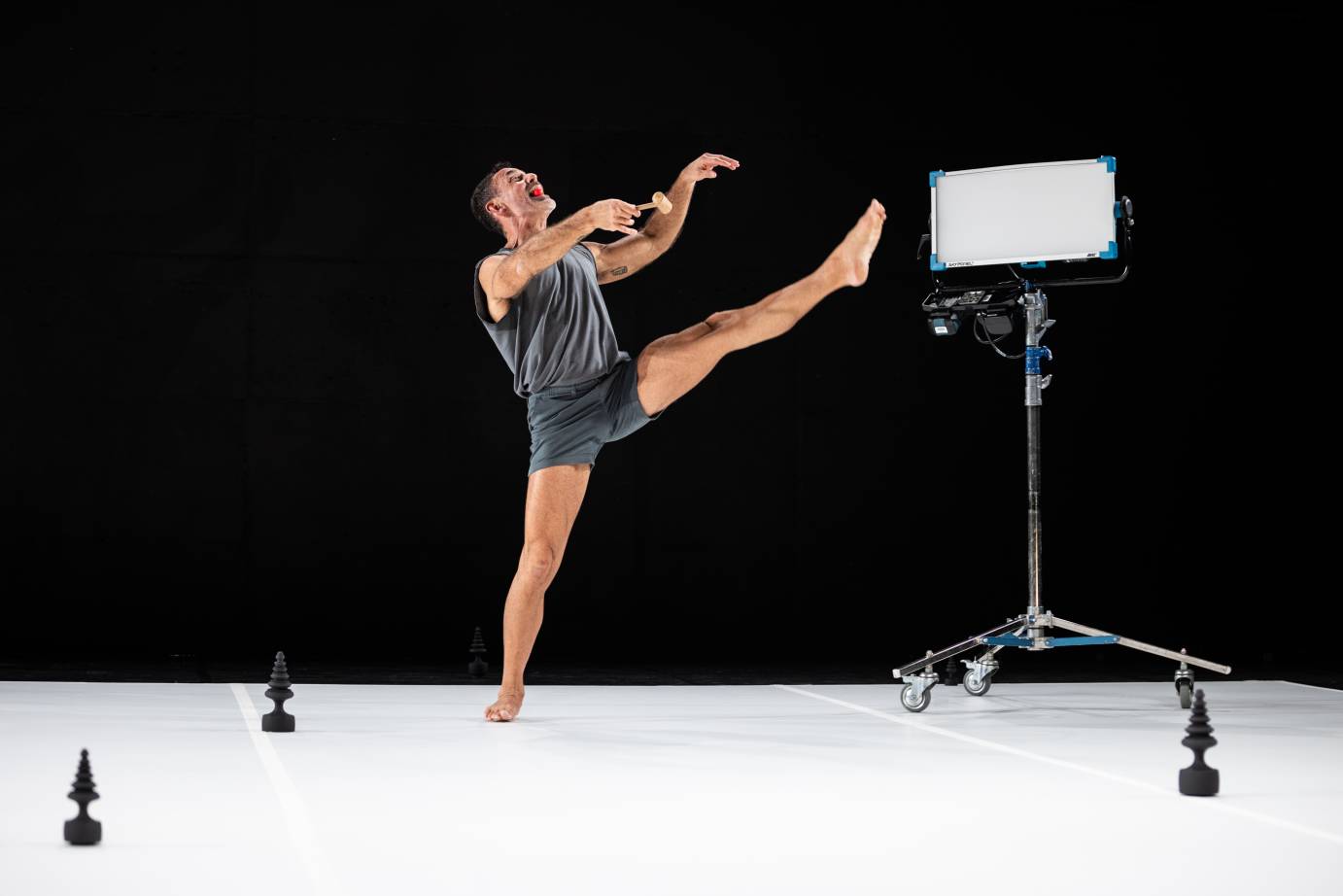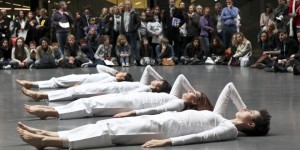IMPRESSIONS: Wally Cardona with Jonathan Bepler in “a plump single-color bulb, or a dance”

Presented by New York Live Arts
Dance, Setting & Performance: Wally Cardona
Music & Performance: Jonathan Bepler
Lighting: Thomas Dunn
Life is tenuous.
But beautiful.
And predictable.
But not.
— Wally Cardona
The brevity and rhythm of Wally Cardona’s epigraph for “a plump single-color bulb, or a dance” is as sparse and affecting as the work itself, which unfolds an extended meditation on the “remarkable mechanism” of curiosity. As creator and performer, Cardona shares this exploration with his musical collaborator and co-performer Jonathan Bepler. Together they enliven an ecosystem of objects — most prominently a small red ball and wooden mallet — and through this process imbue these objects with a curiosity and agency of their own.

Even prior to activation, the stage setting makes a striking impact through visual contrast: a pristine, bright white square of floor gleams against the bare black box of the New York Live Arts theater space. A forest of small black objects, varying in size but otherwise identical, populate the stage space; they stand across the flat divides of dark and snowy expanses, toppled over at the margins, a single white object in the corner. They evoke pygmy evergreen trees or butt plugs — as it turns out, they are casts of sound-making instruments used in Balinese shadow puppet theater — and through their quiet presence grant the otherwise blank stage a sense of space and dimension. A small red ball glows at the border; while tiny, its bright color draws the gaze with absorbing anticipation. Curiosity stirs.
The performers enter and sit, Cardona cross-legged downstage center, fist to forehead, and Bepler at a chair in the upstage corner with his instrument. They settle in, gently fidgeting and clearing their throats; a light strum of the kora’s strings and folding gestures of the arms and hands signal a starting point. They meander with responsive purpose, their two worlds separate but overlapping, honing the grooves of shared practice. For both, curiosity requires a balance of rigor, ease, and attention to the moment to guide choices in modulating texture, volume, speed, and tone. Throughout, their conversation retains a depth of dimensionality that blurs interiority and exchange as organizing logics for experimentation and discovery.

Both artists root their explorations in some form of limitation as a guide through their creative process. For Cardona, the materiality of objects defined the parameters and possibilities of movement and relationship, both with the central ball and mallet as well as the objects of the stage landscape. Bepler chose the kora, a West African stringed instrument with which he was relatively unfamiliar, as a means of guiding harmonic and melodic discovery. In both instances, limitations reveal layers of training and experience and activate the artists’ availability to access sudden and unexpected newness. Curiosity stems from the alchemy of knowing and not knowing, as limitation unveils possibility through responsive exchange.

In performance, a pervasive yet unanxious tension hovers in the physical effort of Cardona’s body and the aural resonance of Bepler’s instrument. Extremes of fullness live side by side with delicate traces; precision of form blooms from morphing pathways. In deep squats, hinges, and moments of balance, Cardona’s heels float barely off the ground as his whole body quivers with exertion; at other times effort isolates to a single limb, drawing attention to the slide of a heel or the cross of an ankle or wrist. Possibilities multiply as the ball and mallet come into play; Cardona does just about everything imaginable except hit the ball directly with the mallet. He manipulates and interrogates the objects singly and together, performing quietly deft sleights of hand and allowing the objects to guide and inform his postures and gestures. The ball’s hard, tiny redness seems to flash between flaring fingers and bared teeth; the small mallet absorbs power and weight as he raises it overhead and lowers it with slow, trembling force.

Bepler’s improvisatory compositions toggle in and out of awareness as he directs sound around the space through modulations of density and volume; he whispers, rises, loops, and settles in unforced conversation with his dancing interlocutor. A melodious burst flows over a passage of ecstatic stillness, filling Cardona’s prostrate form with the deliciousness of repose. Stretches of silence draw out the drama of objects and open space to direct our attention to detail, specificity, and wholeness. Thomas Dunn’s sudden yet subtle lighting shifts — between floods of cool and warm white, between brightness and shadow — craft an atmospheric narrative that eventually explodes into a hypnotic outpouring of saturated color. As the grid lights and a single stage light on wheels shift seamlessly between contrasting and complementary colors, our visual sense traverses dimensions; echoes of these colors resound in our retinas as we return to the bright white blankness, entirely changed.

In this shifting stage space, melodies and geometries spool and unspool, sometimes defined but more often wandering toward or away from definition. The tenor of the artists’ shared exploration eschews the directives and ambitions of searching, favoring instead an open-handed posture of receptivity. In so doing, “a plump single-color bulb, or a dance” becomes an exercise in shared attention as constitutive of shared curiosity, both between the artists and between artists and audience.
As Cardona asks in his dedication, “In times that have no sense or logic, how is it that the need for resolution can fade and simply finding relevance, moment to moment, is enough?”












